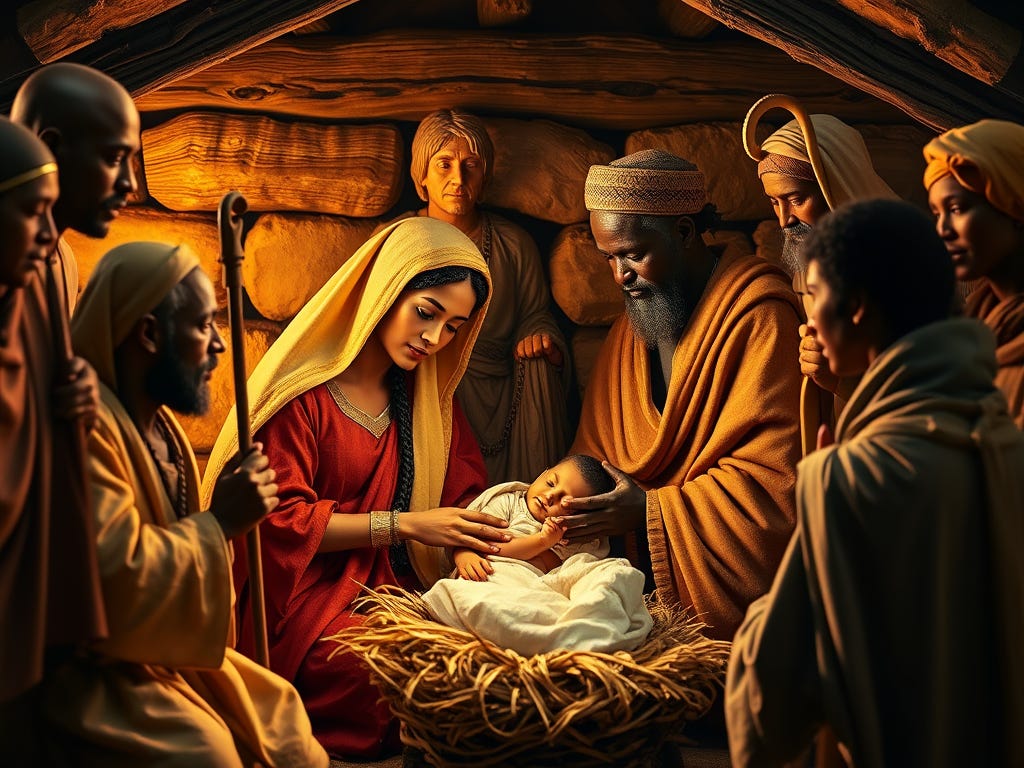In reflecting on the Christmas message this year, I found myself drawn to Paul Lapido’s insightful article, "Diversity and Inclusion Without Equity or Justice is Just Window Dressing." His work offers a clear and necessary reminder that true DEI work is not a superficial exercise—it is about justice, equity, and the dismantling of harmful systems that perpetuate inequality. The themes of justice (mishpat in biblical terms) and equity resonate powerfully throughout scripture, offering a lens to explore not only modern social issues but also the Christmas story itself.
This season provides an opportunity to consider how the birth of Christ intersects with the principles of DEI, especially as it relates to centering those historically marginalized. In particular, Mary's role in the Christmas story challenges deeply entrenched assumptions about power, agency, and who is "qualified" to bring forth God's work. Mary’s faith and her unique calling illuminate the expansive inclusivity of God's kingdom and offer a model of equity and justice we can strive toward today.
Mary: The Improvisational Genius of Faith
For centuries, the societal structures surrounding religious authority centered men as the vessels of God’s word and will. Prophets, priests, and kings—all male—stood as the primary figures through whom divine action unfolded. Yet, in the Christmas story, this assumption is upended dramatically. Mary, a young woman of humble means, is chosen to carry and bring forth Jesus—the Word of God made flesh.
In this act, God elevates a woman into a role of cosmic significance, breaking with expectations and placing Mary at the heart of the divine plan. Through her, the world witnesses an improvisational genius of faith—an ability to say “yes” to a calling that defies societal norms and embodies God’s redemptive work. Mary's inclusion at the center of this story symbolizes a broader, divine commitment to equity. It is not just an individual moment of faith but a radical re-centering of who is deemed capable and worthy in God's economy.
The DEI of the Nativity
The nativity scene itself is a tableau of diversity and inclusion. Shepherds—socially marginalized laborers—are the first to receive the news of Christ's birth. Magi from distant lands, representing different cultures and belief systems, are invited to honor the newborn King. Even the setting—a humble stable—speaks to an inversion of power and privilege. Yet, none of this would hold the transformative power it does without the underlying justice of God’s plan, which includes Mary’s courageous “yes.”
This is a reminder that diversity and inclusion alone are not sufficient. Without equity, the shepherds would have remained unseen. Without justice, the Magi’s journey would lack its deeper purpose. And without Mary’s central role, the Christmas story would fail to challenge the systems of patriarchy that excluded women from positions of spiritual leadership. The nativity is not just a celebration of difference but a revolutionary act of justice that redefines the meaning of worthiness and belonging.
DEI Today: Moving Beyond Performative Inclusion
Paul Lapido’s critique of performative DEI practices resonates deeply with the challenges we face in both secular and religious spaces today. Too often, diversity and inclusion are celebrated in shallow ways—checking boxes and issuing statements—while equity and justice are sidelined. This superficial approach ignores the power dynamics and systemic barriers that have excluded marginalized groups for generations.
True DEI work, as Lapido articulates, involves redistributing power, addressing inequities, and creating environments where marginalized voices can lead and thrive. It means understanding that the work of justice is not optional or ancillary—it is foundational. Just as the Christmas story cannot exist without Mary’s faith and agency, our efforts toward inclusion cannot succeed without equity and justice.
Centering the Marginalized: A Call to Action
This Christmas, let Mary’s story inspire us to reflect on who we center in our lives, communities, and institutions. Let her example remind us of the importance of equity—of creating spaces where the historically excluded are not just invited but empowered to lead. And let the improvisational genius of her faith guide us in embracing justice as a necessary and transformative act.
The Christmas story invites us into a deeper understanding of God’s love—a love that upends hierarchies, centers the marginalized, and calls us all into a more just and inclusive world. As we celebrate this season, let us commit to living out these values, both in our personal lives and in our work for equity and justice.
For more insights into DEI, I highly recommend reading Paul Lapido’s article, "Diversity and Inclusion Without Equity or Justice is Just Window Dressing." His wisdom challenges us to move beyond superficial gestures and embrace the transformative power of justice. Click here to read Paul Lapido's article.
Dr. Nash, The Misogynoir to Mishpat (M2M) Research Network © 2024
Please also follow us on Blue Sky: @M2MResearchNetwork.bsky.social






Thank you for stating what needs to be said and contextualising it through Mary. Season's blessings to you.
Thanks so much for your support!